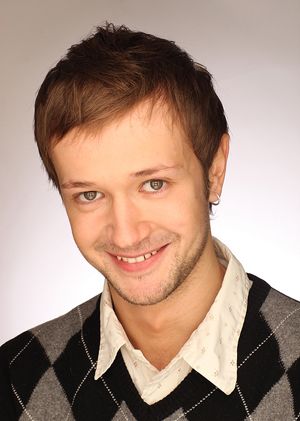
One undoubted discovery was the performance of Mariinsky Theatre dancer Maxim Zyuzin. His Prince, essentially performed to technical perfection, won a great deal from the performer’s acting skills and physical appearance.
Strastnoy Bulvar, 10
Born in Almaty (Kazakhstan).
Graduated from the Vaganova Ballet Academy in 2001.
Joined the Mariinsky Ballet the same year.
Repertoire includes:
Giselle (Albrecht, Classical duet from Act I); choreography by Jean Coralli, Jules Perrot and Marius Petipa,
La Sylphide (Youths); choreography by August Bournonville, revised version by Elsa-Marianne von Rosen,
La Fille du Pharaon (Fisherman); choreography by Marius Petipa reconstructed by Toni Candeloro,
Le Corsaire (Conrad, Lankedem); choreography by Pyotr Gusev after the composition by Marius Petipa,
La Bayadère (Magdaveya, Toloragva); choreography by Marius Petipa, revised version by Vakhtang Chabukiani,
The Sleeping Beauty (Prince Charming, Prince Chéri, Prince Fleur de Pois, the Blue Bird); choreography by Marius Petipa, revival of the 1890 production,
The Sleeping Beauty (Prince Désiré, the Blue Bird); choreography by Marius Petipa, revised version by Konstantin Sergeyev,
Swan Lake (Prince Siegfried, Pas de trois); choreography by Marius Petipa and Lev Ivanov, revised version by Konstantin Sergeyev,
Raymonda (Jean de Brienne, Béranger, Bernard, Grand pas); choreography by Marius Petipa, revised version by Konstantin Sergeyev,
Don Quixote (Gamache, Espada); choreography by Alexander Gorsky after motifs of Marius Petipa’s production,
Le Réveil de Flore (Mercure); choreography by Marius Petipa, revival of the 1894 production, staged by Sergei Vikharev,
Chopiniana (Nocturne, Mazurka, Seventh Waltz, First Waltz), The Firebird (Ivan Tsarevich), Le Carnaval (Pantalone); choreography by Michel Fokine,
Le Sacre du printemps (Elders, Youths); choreography by Vaslav Nijinsky,
The Fountain of Bakhchisarai (Vaslav, Tatar Dance, Youths); choreography by Rostislav Zakharov,
The Nutcracker (the Nutcracker Prince, Jester); choreography by Vasily Vainonen,
Leonid Lavrovsky’s ballets Romeo and Juliet (Romeo, Mercutio, Paris, Troubadour) and Walpurgis Night (Satyr),
Spartacus (Harmodius, Satyr); choreography by Leonid Yakobson,
Yuri Grigorovich's ballets The Stone Flower (Danila) and The Legend of Love (Ferkhad’s Friends),
Leningrad Symphony (Youth); choreography by Igor Belsky,
Carmen (Bandit); choreography by Roland Petit,
Anyuta (Pyotr Leontievich); choreography by Vladimir Vasiliev,
George Balanchine’s ballets Prodigal Son (Prodigal Son, Friends of the Prodigal), Jewels (Emeralds, Diamonds), The Four Temperaments (Melancholic), Tchaikovsky Pas de Deux, Piano Concerto No 2 (Ballet Imperial), La Valse, Symphony in C (First Movement, I. Allegro vivo, IV. Allegro vivace) and Theme and Variations, A Midsummer Night’s Dream (Demetrius),
Now and Then; choreography by John Neumeier,
Études (Dancers); choreography by Harald Lander,
Carmen-Suite (Torero); choreography by Alberto Alonso,
The Nutcracker (the Nutcracker Prince, Drosselmeyer, Pulcinella, Mother Gigogne); staging by Mihail Chemiakin and choreography by Kirill Simonov,
Cinderella (the Prince, Autumn, Winter, Male Dance, Dance Teacher), The Little Humpbacked Horse (Ivan the Fool, The Gentleman of the Bedchamber, Gavrilo) and Anna Karenina (Vronsky, Levin) and Pierot Lunaire,
William Forsythe’s ballets Approximate Sonata, The Vertiginous Thrill of Exactitude, In the Middle, Somewhat Elevated,
Come in!; choreography by Kirill Simonov,
Dolce, con fuoco; choreography by Svetlana Anufrieva,
The Magic Nut (Hungarian Groom, the Young Drosselmeyer); staging by Mihail Chemiakin and choreography by Donvena Pandoursky,
Princess Pirlipat, or Worthiness Punished (Turkish Grooms); production by Mihail Chemiakin, choreography by Kirill Simonov, (Turkish Grooms),
Metaphysics (The Man); choreography by Donvena Pandoursky,
The Ghostly Ball; choreography by Dmitry Bryantsev,
The Ring; choreography by Alexei Miroshnichenko,
Aria Suspended; choreography by Peter Quanz,
Glass Heart (Alexander); choreography by Kirill Simonov,
Nirvana, Ricochet and Simple Things; choreography by Emil Faski,
Symphony in Three Movements (He); choreography by Radu Poklitaru,
Bolero Factory (Envy); choreography by Yuri Smekalov,
The Bronze Horseman (Ibrahim the Blackmoor); choreography by Rostislav Zakharov, Yuri Smekalov,
Paquita (Clemente); choreography by Yuri Smekalov, reconstruction and staging of Marius Petipa's choreography (Act III Grand Pas) by Yuri Burlaka,
Without; choreography by Benjamin Millepied,
Euphoria; choreography by Nikita Dmitrievsky,
Infra; choreography by Wayne McGregor,
Vladimir Varnava's ballets A Window on Deep Midwinter, Clay,
Russian Overture; choreography by Maxim Petrov,
The Four Seasons; choreography by Ilya Zhivoi,
Coppélia (Coppélius), 12 (Part I), At the Wrong Time; choreography by Alexander Sergeev.
Repertoire also includes:
Grand Pas Classique; choreography by Viktor Gsovsky,
Connections; choreography by Ilya Zhivoi,
Celestial; choreography by Garrett Smith,
Divertimento, Concertino bianco; choreography by Dmitry Pimonov,
as part of the project The Dreamers: Lose Yourself to Dance; choreography by Maxim Petrov and Ilya Zhivoi, Motherboard; choreography by Ilya Zhivoi,
and the pas de deux from the ballet The Talisman; choreography by Marius Petipa.
On 23 February 2014 he took part in the closing ceremony of the XXII Winter Olympic Games in Sochi.